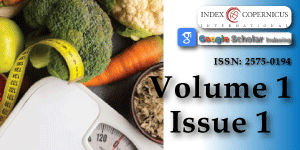Effect of Pre-Treatments and Drying Methods on the Chemical Quality and Microbial Density of Wild Edible Oyster Mushroom
Main Article Content
Abstract
This study was carried out to evaluate the effect of pretreatments and drying methods on the chemical quality and microbial density of wild edible oyster mushroom. The mushroom samples were pretreated by steeping in 0.5% citric and sodium metabisulphite at room temperature for 10 minutes before being subjected to sun and cabinet drying until a constant weight was reached. The dried samples including the control samples (Samples not pretreated with chemicals) were evaluated for proximate, mineral composition and microbial density. The proximate analysis (protein, ash, fat, moisture and fibre) showed that untreated mushroom samples (both sun and cabinet dried) had the overall best results followed by samples pretreated with 0.5% sodium metabisulphite while samples pretreated with 0.5% citric acid had the lowest values. The mineral analysis (calcium, sodium, magnesium and potassium) of the mushroom samples followed the same trend as the proximate analysis. The microbial density of the samples showed that samples pretreated with 0.5% citric acid had the lowest count followed by samples pretreated with 0.5% sodium metabisulphite while the untreated samples had the highest microbial density. This implies that pretreatment with citric acid and sodium metabisulphite reduced the microbial density which may invariably extend the storage life of the edible oyster mushroom.
Article Details
Copyright (c) 2017 Ibrahim TA, et al.

This work is licensed under a Creative Commons Attribution 4.0 International License.
Walde SG, Velu V, Jyothirmayi T, Math RG. Effects of pretreatments and drying methods on dehydration of mushroom. Journal of Food Engineering. 2006; 74: 108-115. Ref.: https://goo.gl/RfLwP9
Chang ST, Buswell JA. Mushroom nutraceuticals. World J Microbial Biotechnical. 1996; 12: 473-476. Ref.: https://goo.gl/QaeiZq
Yapar S, Helvaci SS, Peker S. Drying behavior of mushroom slices. Drying Technology. 1990; 8: 77-79. Ref.: https://goo.gl/HFEp8M
Kelshrewtha M, Singh A, Vipal D. Effect of drying conditions on mushrooms quality. Journal of engineering science and technology. 2009; 4: 96-98.
Kalač P. A review of chemical composition and nutritional value of wild-growing and cultivated mushrooms. J Sci Food Agric. 2013; 93: 209-218. Ref.: https://goo.gl/R85tw3
Alam SM. Importance of mushrooms. NIA, Tando Jam, Pakistan, (2008).
Lidhoo CK, Agrawal YC. Hot-air over drying characteristics of button mushroom-safe drying temperature. Mush Res. 2006; 15: 59-62.
Argyropoulos D, Heindl A, Müller J. Evaluation of processing parameters for hot-air drying to obtain high quality dried mushrooms in the Mediterranean region. Conference on International Research on Food Security, Natural Resource Management and Rural Development, Tropentag. 2008; 7-9. Ref.: https://goo.gl/j7mwNa
Suguna S, Usha M, Narayanan VV, Raghupathy R, Gothandapani L. Dehydration of mushroom by sun drying, thin layer drying, fluidized bed drying and solar cabinet drying. J Fd Sci Technol. 1995; 34: 284-288.
Alan B, Arleen BR, Fischer DW. Mushrooms of Northeastern North America. Hong Kong: Library of Congress Cataloging-in-Publication Data. 1997.
Arora S, Shivhare US Ahmed J, Raghavan GSV. Drying kinetic of Agarius bisporuns and pleurotus florida mushroom. American society of Agriciltural Engineers. 2003; 46: 721-724. Ref.: https://goo.gl/R9kY2o
AOAC. Official methods of analysis. Association of official analytical chemists. Washington D.C., USA. 2005
Chang S, Miles PG. Mushrooms, Cultivation, Nutritional Value, Medicinal Effect, and Environmental Impact, CRC Press, America. 2004.
Rama V, John PJ. Effects of methods of drying and pretreatments on quality of dehydrated mushroom. Indian Food Packer. 2000; 54: 59-64.
WHO. World Health Organization Technical series. Trace elements in human nutrition and health. World Health Organization, Geneva. 2005; 199-205.
Mattila P, Könkö K, Eurola M, Pihlava JM, Astola J. Contents of vitamins, mineral elements, and some phenolic compounds in cultivated mushrooms. J Agric Food Chem. 2001; 49: 2343-2348. Ref.: https://goo.gl/e1XYMa
Czapski J. Evaluation of chemical composition of commercially canned mushrooms processed from fresh and desalted mushrooms and derived from different geographic regions. Veg Crops Res Bull. 2003; 58: 135-141.
Komanowooky M, Talley FB, Eskew RK. Air drying of culyivated mushrooms. Food Technology. 1997; 32: 1020-1024.
Aishah MS, Wan Rosli WI. Effect of different drying techniques on the nutritional values of oyster mushroom pleurotus sajor-caju. Saina Malaysian. 2013; 42; 937-941.
Singh U, Jain SK, Doshiz A, Jain HK, Chahar VK. Effects of pretreatments on drying characteristics of button mushroom. International Journal of Food Engineering. 2008; 4.
ICMSF. International Commission on Microbiology for Specification for Food. Microorganisms in Food: Their Significance and Methods of Enumeration. 2nd Edn., University of Toronto Press, Toronto, Canada. 1978.

